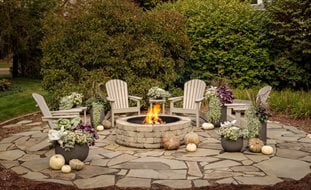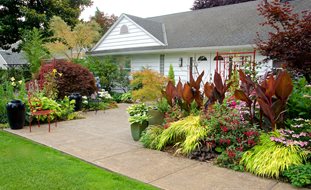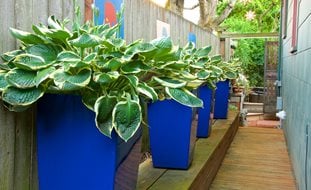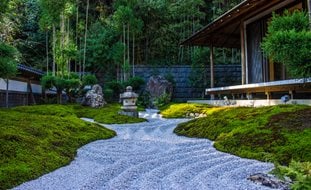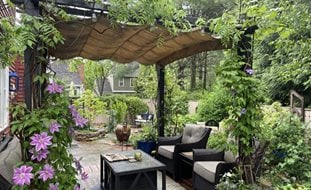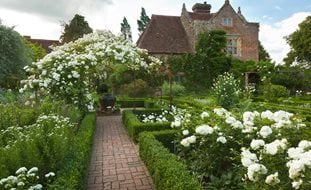Hillside Landscaping Ideas for a Sloped Yard
Learn how to upgrade a slope with these ideas and tips.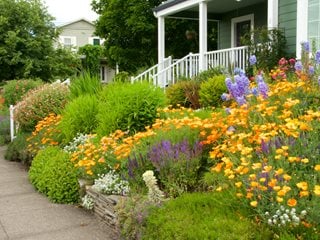
Cottage-style plantings adorn an urban front yard slope, which is reinforced with a stacked rock wall. Designer: David Coennen. Photo: Janet Loughrey.
A hillside property may offer scenic vistas or other advantages, but can also present some of the biggest landscaping challenges. Slopes are more susceptible to soil erosion and drainage issues, and a steep or uneven hillside can be difficult to navigate, making landscape installation and maintenance more difficult.
A gentle slope is easier to deal with than a steep incline. It’s important to evaluate your property to come up with the most effective solutions for creating a beautiful landscape while keeping yourself and your property safe. Here are some things to look for, along with hillside landscaping ideas to get you started.
PRELIMINARY CONSIDERATIONS
Evaluate your slope.
Determine the grade of your hillside, whether it’s slight, medium or steep. This will help you decide what solutions will be most effective. A slight grade may be controlled with rocks, mulch, and plants to anchor the soil, while a medium grade may benefit from more stabilization with the installation of landscape fabric beneath topsoil or mulch. Steep hillsides will require sturdier measures for controlling erosion, such as a retaining wall or terracing.
Analyze the soil.
The type of soil will affect how well the slope drains and how much erosion might occur. Sand and silt drain more quickly and are more prone to erosion than clay. Less stable soil may require a sturdier option such as a retaining wall.
Consider drainage.
Make sure there’s adequate drainage to reduce erosion and prevent walls from developing cracks, shifting, or collapsing. Water runoff that collects at the bottom of a slope may need to be diverted with a French drain or other drainage system.
Determine access.
How easy is it to get around your slope? If doing the work and maintenance yourself, are you able to go up and down the hillside safely?
Consult a professional.
For a difficult property or complex renovation, it’s advisable to hire a landscape designer, contractor, or architect who can evaluate your property and offer professional advice. This is especially crucial if you live in an area that’s prone to slides, and if you are adding features such as rock walls, retaining walls, waterfalls, and berms that require specialized equipment and expertise.
MAKE A PLAN
Draw up a design.
Make a rough sketch yourself, or consult a landscape professional for a more elaborate design.
Get inspired.
Look for hillside landscaping ideas by searching online or visiting local gardens. Seek out similar properties to find out what worked and what didn’t.
Design for accessibility.
Make accessibility a top consideration in the design. The easier it is to get around the hillside, the safer it will be, the easier it will be to maintain, and the more time you’ll spend outdoors.
Consider scale.
Choose hardscape materials such as boulders or rocks that will complement the scale of the space. Make sure materials will help secure the slope rather than making it less stable.
Choose a style.
Pick a theme, materials, and plants that will harmonize with your home’s exterior. Rough boulders, railroad ties, and native plants will complement more natural-looking houses, while cleaner materials and formal plantings will blend with more modern architecture.
Create a destination.
Construct a patio, seating area, or fire pit where you can take advantage of views of your home or the surrounding landscape. These areas also serve as focal points to draw your eye up and down the slope.
Plan garden beds.
Decide what kind of garden areas you’d like to include, whether it’s a mixed border, rock garden, shade border, vegetable plot, or water-wise strip.
TYPES OF SLOPE STABILIZATION

This moderate slope is stabilized with a combination of rock walls, cement steps, groundcovers, and hedging. Photo: Janet Loughrey.
Mulch.
This is a low-cost solution for a gently sloped yard that helps prevent the loss of topsoil, suppress weeds, and retain moisture.
Landscape fabric.
Landscape fabric can stabilize a gentle or moderate slope and keep soil from eroding. The disadvantage to landscape fabric is that it will eventually break down, compact the soil and may stunt root development.
Rocks or boulders.
Individual rocks or boulders can be arranged along a hillside to help prevent soil erosion. For steeper grades, choose angular boulders that can dig into the soil rather than smooth rocks that are more prone to rolling or washing away.
Soil or wooden berm.
This can provide a more gentle transition to different levels.
Rock wall.
A rock wall is comprised of stacked rocks that are loose or adhered together. Place stone walls at the back of a property, adjacent to a sidewalk, or to define different levels on the property.
Retaining wall.
A retaining wall helps stabilize the soil and define different areas. This is a good solution for a steep slope, and may entail cutting away a portion of the hillside and constructing a vertical wall to hold the soil. Materials can be rocks, bricks, cinder blocks, cement, railroad ties, or other lumber.
Terracing.
A steep hillside can be divided into different levels with a series of retaining walls and flat surfaces in between. The flat areas help control runoff and can be used for planting flowers, seating areas, or recreational opportunities.
Stairways and pathways.
These features will help with stabilization, allow easier access, and connect different areas together. Steps can consist of stone blocks, slabs, or wood for a steeper slope. Pavers or gravel are appropriate for a gentler grade. Create switchbacks on steeper slopes to make pathways safer to navigate.
Waterfall.
Take advantage of elevation change by installing a tumbling waterfall in a sloped backyard. Use materials that will help stabilize a hillside as well as lend aesthetic beauty.
Vegetation.
Turf grass and other plants help anchor a slope or hillside. If choosing turf, make sure the slope can be easily mowed and maintained.
PLANTS FOR A HILLSIDE LANDSCAPE

This hillside with a medium grade is softened with an engaging mix of trees, shrubs, perennials, and groundcovers. Gardener: Nancy Plumlee. Designer: Lori Scott. Photo: Janet Loughrey.
A hillside garden is different to plan for than a flat area. Plant roots will help stabilize a hillside and stem erosion, while foliage provides a canopy that slows water absorption during heavy rains. These can include trees, shrubs, perennials, and creeping groundcovers, with some varieties more effective than others. Here’s what to look for, along with some of the best plants to use.
Plant selection.
Choose plants for hillside landscapes that will develop a deep root system and spread quickly to cover bare soil. Consider microclimates: rock walls will absorb sun, making adjacent planting beds warmer, while shady areas will be cooler. Native varieties have the added benefits of low maintenance and supporting pollinators and wildlife.
Light conditions.
Note how the sun moves over the property throughout the day and in different seasons. Choose plants according to their light needs of full sun, partial sun or shade.
Mix it up.
Grow plants of different types including groundcovers, perennials, trees, and shrubs to create an attractive layered tapestry.
Siting plants.
For more efficient water usage and healthier plants, group varieties together with similar watering needs. Since water runs downhill, site drought-tolerant plants towards the top of a slope, with thirstier varieties towards the bottom.
| Sun | Shade | |
|---|---|---|
| GROUND COVERS | Creeping phlox, rockspray cotoneaster, creeping sedum, candytuft, liriope, ajuga | Sorrel (Oxalis), bunchberry dogwood (Cornus canadensis), dead nettle (Lamium), vinca, Japanese spurge (Pachysandra), wild ginger (Asarum caudatum) |
| PERENNIALS | Sedges and other ornamental grasses, coneflower, stonecrop (Sedum), yarrow, salvia, dianthus | Hosta, astilbe, ferns, Solomon's seal, coral bells, epimedium |
| SHRUBS | Spirea, mockorange (Philadelphus), elderberry (Sambucus), creeping juniper, forsythia, sumac, quince | Euonymus snowberry, Oregon gape, salal, huckleberry, rhododendron, St. John's wort |
| TREES | Dogwood, witch hazel, hawthorn, native willow (Salix hookeriana), pine | Vine maple, Japanese maple, redbud, beech, serviceberry |
MAINTAINING A HILLSIDE GARDEN
Select durable materials.
When building retaining walls or other structures, use the most durable materials that you can afford. Cement blocks will last longer than wooden railroad ties.
Use high-quality soil.
Plants will be healthier and need less fertilization when using higher quality topsoil, amendments, and mulch.
Keep garden areas mulched.
A layer of mulch reduces the need for chores such as weeding and watering.
Choose carefree plants.
Use varieties that need little or no pruning, fertilizing, or watering to create a low-maintenance hillside landscape.
Irrigation.
Install drip irrigation to make watering chores easier. A drip system is more efficient and allows water to more slowly penetrate the soil, helping to stem erosion. Overhead watering or sprinklers may cause surface runoff and may not penetrate the soil.
Enlist help.
Use a professional maintenance crew for challenging slopes.
HILLSIDE LANDSCAPING ON A BUDGET
Here are a few ways to reduce the costs of landscaping on a slope:
Invest wisely.
Don’t skimp on structural features to ensure longevity and safety of the slope.
Do it yourself.
Do some or all of the work yourself rather than solely relying on a designer or contractor. Online videos and other resources can offer guidance.
Recycle.
Get landscape rocks, topsoil, or other hardscaping materials on free sites or online groups. Some cities offer free or low-cost compost. Other free hardscape sources may include recycled concrete from sidewalk demolition or other deconstruction projects, or wilderness areas that allow permitted rock collecting.
Bargain hunt.
Peruse nurseries for end of the season sales on plants and hardscape materials.
Trade.
Join a plant exchange group to trade plants for free.
Plant selection.
Choose plant varieties that will quickly mature or fill in. Select varieties that are hardy, long-lived, and fail-proof to minimize plant losses. Use water-wise plants to save on water bills.
Substitute less expensive materials.
Gravel for pathways and patios is cheaper than cut stone, bricks, or pavers.

HILLSIDE LANDSCAPING IDEAS

Brick walls and stairways define the sloped transition between the street and home. Gardener: Bud Deitrich. Photo: Janet Loughrey.

A captivating combination of cement walls, stairways, and shade plantings define the steep slope of this modern-style urban garden. Designer: Laura Crockett. Photo: Janet Loughrey.

Dfferent levels and angled pathways compel visitors to explore this terraced hillside garden. Lush shade plantings soften the angular lines of the hardscape. Designer: Laura Crockett. Photo: Janet Loughrey.

A gentle slope defined by a rustic rock wall and stone steps leads to a secluded backyard seating area. Designer: Philip Thornburg. Photo: Janet Loughrey.

Cottage-style plantings adorn an urban front yard slope, which is reinforced with a stacked rock wall. Designer: David Coennen. Photo: Janet Loughrey.

A stone paver pathway on a gentle slope connects a spacious lawn to a patio area. Lush plantings soften the rock walls, lending richness to the landscape. Designers: Anne Marsh and Gary Fear. Photo: Janet Loughrey.

The main feature of this backyard slope is a babbling stream with a series of waterfalls. A gravel pathway that allows access for maintenance leads to a quiet seating area surrounded by lush plantings. Designers: Anne Marsh and Gary Fear. Photo: Janet Loughrey.

This hillside with a medium grade is softened with an engaging mix of trees, shrubs, perennials, and groundcovers. Gardener: Nancy Plumlee. Designer: Lori Scott. Photo: Janet Loughrey.

A grand double waterfall anchors this moderately graded slope. Irregular boulders and rocks lend the appearance of a natural stream. Designer: Laura Crockett. Photo: Janet Loughrey.

This moderate slope is stabilized with a combination of rock walls, cement steps, groundcovers, and hedging. Photo: Janet Loughrey.

For this wooded backyard with a moderate grade, multiple solutions include large boulders, a paver pathway, and shade plantings of ferns, grasses, perennials, and shrubs. Designer: Philip Thornburg. Photo: Janet Loughrey.


